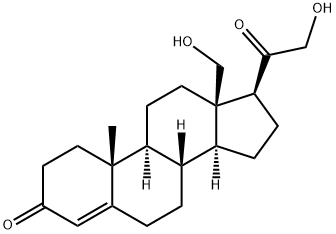18-hydroxy-11-deoxy Corticosterone (18-OH-DOC) is a mineralocorticoid secreted by the zona fasciculata of the adrenal gland. Its biosynthesis is regulated by adrenocorticotropic hormone (ACTH; ) as well as angiotensin II , which increases 18-OH-DOC production in isolated human adrenal glomerulosa cells. 18-OH-DOC can be formed via conversion of 11-deoxy corticosterone (DOC; ) in human SK-MEL188 melanoma cells. 18-OH-DOC is an intermediate in the metabolism of progesterone and can be converted to aldosterone by the capsular portion of rat adrenal glands. Continuous infusion of 18-OH-DOC (200 μg/rat per day) increases systolic blood pressure in uninephrectomized saline-drinking rats. Plasma levels of 18-OH-DOC are elevated in a db/db mouse model of type 2 diabetes.
11-Deoxy-18-hydroxycorticosterone is an analog of Corticosterone (C695700); a glucocorticoid and intermediate in the biosynthesis of Aldosterone (A514700) which is an adrenocortical steroid isolated from the adrenal cortex.
ChEBI: 18-hydroxydeoxycorticosterone is a 21-hydroxy steroid, a 3-oxo-Delta(4) steroid, a 20-oxo steroid and a 18-hydroxy steroid.
Recrystallise 18-hydroxy-11-deoxycorticosterone from Et2O/Me2CO to give crystals m 200-205o. When it is recrystallised from M2CO, it has m 191-195o. It has UV with max at 240nm. The 21-O-acetoxy-18-hydroxy derivative has m 158-159o (from Et2O/*C6H6), and the 21-O-acetoxy-18,20-epoxy derivative has m 149-154o (from Et2O). [Kahnt et al. Helv Chim Acta 38 1237 1955; Pappo J Am Chem Soc 81 1010 1959.]
